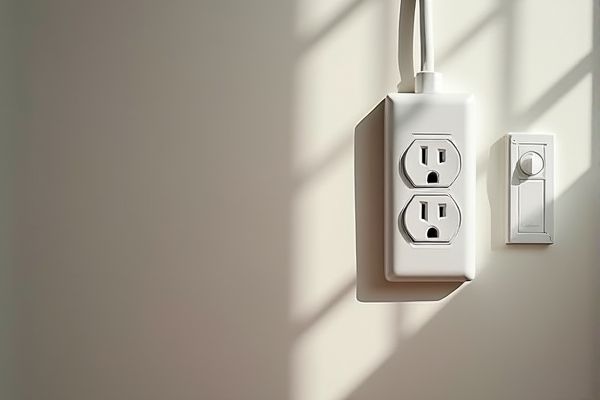
A power strip simply expands the number of available electrical outlets, while a surge protector safeguards your devices from voltage spikes that can cause damage. To understand the differences and ensure the safety of your electronics, explore the rest of this article.
Table of Comparison
| Feature | Power Strip | Surge Protector |
|---|---|---|
| Primary Function | Expands number of outlets | Protects devices from voltage spikes |
| Surge Protection | No | Yes, with joule rating |
| Joule Rating | None | Typically 200 to 4000 joules |
| Ideal Use | Basic device connectivity | Sensitive electronics & appliances |
| Cost | Lower | Higher |
| Indicator Lights | Rare | Common (protection status) |
Introduction to Power Strips and Surge Protectors
Power strips provide multiple outlets to expand your electrical access but lack protection against voltage spikes. Surge protectors include built-in components that guard your devices from power surges caused by lightning or electrical faults. Understanding the difference helps you choose the right solution to protect your valuable electronics.
Defining Power Strips
Power strips are electrical devices that provide multiple outlets from a single socket, enabling users to connect several devices simultaneously. Unlike surge protectors, standard power strips do not offer protection against voltage spikes or power surges, making them less suitable for sensitive electronics. They are primarily designed for convenience and expanded connectivity rather than electrical safety.
What is a Surge Protector?
A surge protector is an advanced electrical device designed to shield your electronic equipment from voltage spikes by diverting excess electricity to the ground. Unlike a basic power strip that only provides multiple outlets, a surge protector contains internal components such as metal oxide varistors (MOVs) that absorb and dissipate sudden surges caused by lightning or power outages. Ensuring you use a surge protector can prevent damaging electrical surges, extending the lifespan of your valuable devices.
Key Differences Between Power Strips and Surge Protectors
Power strips primarily expand the number of available electrical outlets, allowing you to plug in multiple devices simultaneously, while surge protectors include specialized components designed to shield your electronics from voltage spikes and power surges. Surge protectors use metal oxide varistors (MOVs) to divert excess voltage and prevent damage, a feature that standard power strips lack. Choosing the right device is essential for safeguarding your valuable equipment, especially in areas prone to electrical disturbances.
Electrical Safety Considerations
Surge protectors offer advanced electrical safety by incorporating components like Metal Oxide Varistors (MOVs) that absorb voltage spikes, preventing damage to connected devices. Power strips primarily provide additional outlets without built-in surge protection, leaving electronics vulnerable to power surges and spikes. Choosing a surge protector with a high Joule rating ensures better protection against electrical hazards and enhances overall safety.
When to Use a Power Strip
A power strip is ideal for expanding the number of available electrical outlets in low-risk environments where devices do not require protection from voltage spikes, such as charging phones or powering lamps. It should be used when multiple electronics need to be plugged in simultaneously without the need for surge protection. For sensitive equipment like computers or home entertainment systems, a surge protector is recommended instead.
When a Surge Protector Is Necessary
A surge protector is necessary when you want to safeguard your electronic devices from voltage spikes and power surges that can cause permanent damage. Unlike a basic power strip that only provides additional outlets, a surge protector contains components like metal oxide varistors (MOVs) to absorb excess voltage and prevent it from reaching your equipment. You should use a surge protector for sensitive electronics such as computers, gaming consoles, and home theater systems to ensure long-term protection and avoid costly repairs.
Tips for Choosing the Right Device
When choosing between a power strip and a surge protector, prioritize devices with built-in surge protection rated by joules to safeguard your electronics from voltage spikes. Look for multiple outlets and USB ports to accommodate your devices efficiently while considering the maximum load capacity to prevent overloading. You should also check for certifications like UL listing for safety assurance and choose a model with an indicator light to confirm active surge protection.
Common Misconceptions and Mistakes
Many people confuse power strips with surge protectors, assuming they offer the same level of protection against voltage spikes. Power strips primarily provide additional outlets but lack the internal components to absorb surges, risking damage to connected devices during electrical spikes. Using a power strip instead of a surge protector for sensitive electronics like computers or home theater systems can lead to costly hardware failure.
Conclusion: Making the Right Choice for Your Devices
Choosing between a power strip and a surge protector depends on your need for device safety and power management. Surge protectors offer essential protection against voltage spikes, making them ideal for sensitive electronics like computers and home entertainment systems, while basic power strips simply expand outlet capacity without safeguarding your devices. Protecting your valuable electronics with the appropriate equipment ensures longevity and prevents damage from unexpected power surges.
 homyna.com
homyna.com